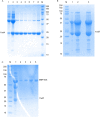Protein purification and crystallization artifacts: The tale usually not told
- PMID: 26660914
- PMCID: PMC4815408
- DOI: 10.1002/pro.2861
Protein purification and crystallization artifacts: The tale usually not told
Abstract
The misidentification of a protein sample, or contamination of a sample with the wrong protein, may be a potential reason for the non-reproducibility of experiments. This problem may occur in the process of heterologous overexpression and purification of recombinant proteins, as well as purification of proteins from natural sources. If the contaminated or misidentified sample is used for crystallization, in many cases the problem may not be detected until structures are determined. In the case of functional studies, the problem may not be detected for years. Here several procedures that can be successfully used for the identification of crystallized protein contaminants, including: (i) a lattice parameter search against known structures, (ii) sequence or fold identification from partially built models, and (iii) molecular replacement with common contaminants as search templates have been presented. A list of common contaminant structures to be used as alternative search models was provided. These methods were used to identify four cases of purification and crystallization artifacts. This report provides troubleshooting pointers for researchers facing difficulties in phasing or model building.
Keywords: YadF (carbonic anhydrase); YodA (metal-binding lipocalin); crystallization artifacts; protein purification artifacts; reproducibility.
© 2016 The Protein Society.
Figures


References
-
- Chu CK, Feng LL, Wouters MA (2005) Comparison of sequence and structure‐based datasets for nonredundant structural data mining. Proteins 60:577–583. - PubMed
-
- Bolanos‐Garcia VM, Davies OR (2006) Structural analysis and classification of native proteins from E. coli commonly co‐purified by immobilised metal affinity chromatography. Biochim Biophys Acta 1760:1304–1313. - PubMed
-
- Gräslund S, Nordlund P, Weigelt J, Hallberg BM, Bray J, Gileadi O, Knapp S, Oppermann U, Arrowsmith C, Hui R, Ming J, dhe‐Paganon S, Park HW, Savchenko A, Yee A, Edwards A, Vincentelli R, Cambillau C, Kim R, Kim SH, Rao Z, Shi Y, Terwilliger TC, Kim CY, Hung LW, Waldo GS, Peleg Y, Albeck S, Unger T, Dym O, Prilusky J, Sussman JL, Stevens RC, Lesley SA, Wilson IA, Joachimiak A, Collart F, Dementieva I, Donnelly MI, Eschenfeldt WH, Kim Y, Stols L, Wu R, Zhou M, Burley SK, Emtage JS, Sauder JM, Thompson D, Bain K, Luz J, Gheyi T, Zhang F, Atwell S, Almo SC, Bonanno JB, Fiser A, Swaminathan S, Studier FW, Chance MR, Sali A, Acton TB, Xiao R, Zhao L, Ma LC, Hunt JF, Tong L, Cunningham K, Inouye M, Anderson S, Janjua H, Shastry R, Ho CK, Wang D, Wang H, Jiang M, Montelione GT, Stuart DI, Owens RJ, Daenke S, Schütz A, Heinemann U, Yokoyama S, Büssow K, Gunsalus KC (2008) Protein production and purification. Nature Meth 5:135–146. - PMC - PubMed
-
- Khan NA (2004) HPLC of peptides and proteins: methods and protocols, edited by Marie‐Isabel Aguilar (methods in molecular biology, volume 251, series editor J. M. Walker). Humana Press, Totowa, NJ, 2003, 413 pp, ISBN: 0‐86903‐977‐3. Biomed Chromatogr 18:475.
Publication types
MeSH terms
Substances
Grants and funding
LinkOut - more resources
Full Text Sources
Other Literature Sources
Molecular Biology Databases

